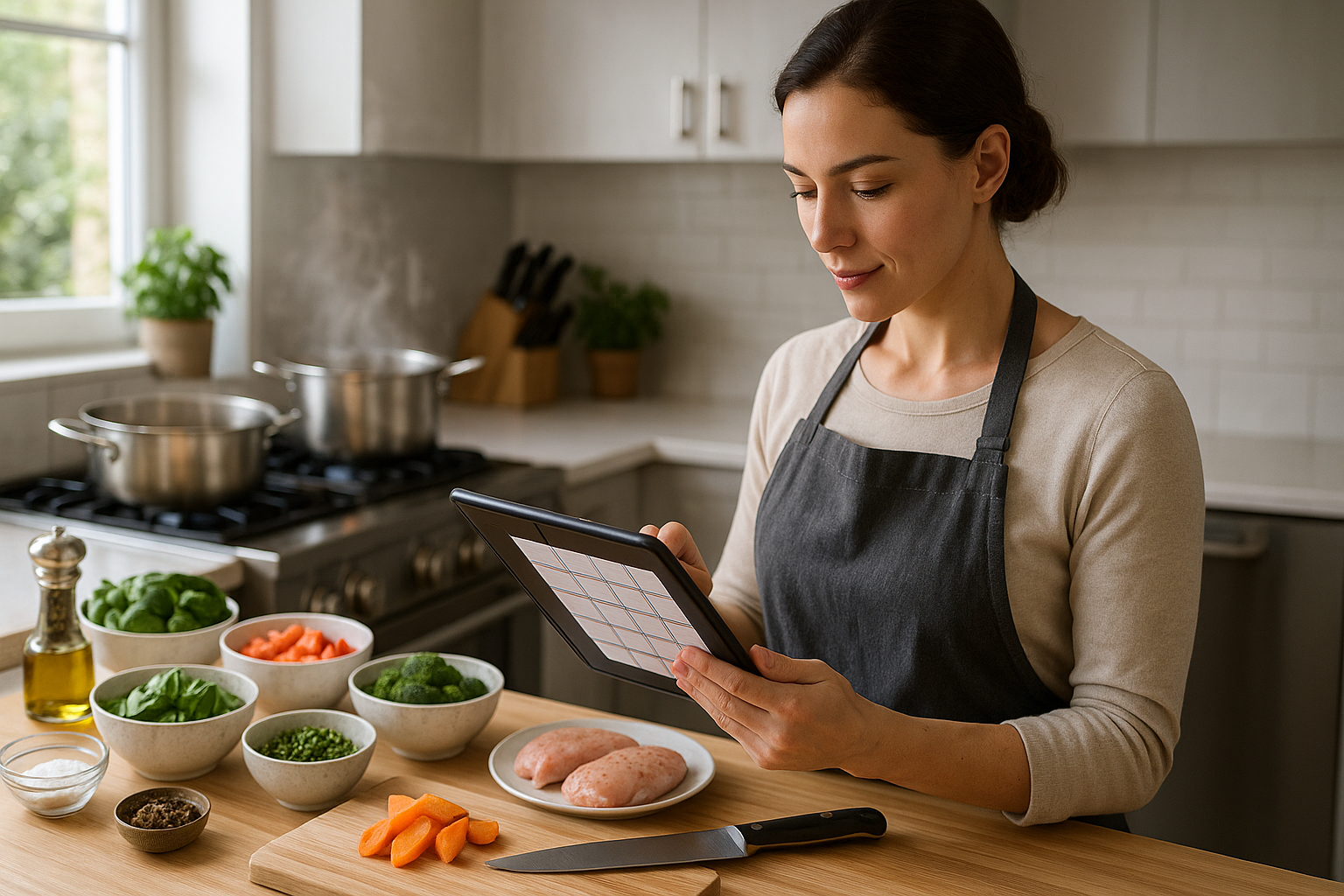🔮 What if you could time-block your way into becoming a more efficient, stress-free, and successful home chef? Well, it’s no longer a hypothetical question. In this in-depth exploration, we’re diving into the game-changing concept of time-blocking for effortless cooking success.
While this may sound like a concept from a sci-fi novel, rest assured, it’s grounded in practicality and attainability. Just as software developers use time-blocking to manage complex projects, home chefs can borrow this productivity strategy to optimize their meal preparation processes, regardless of their cooking skills. 🍳
The beauty of time-blocking lies in its flexibility and adaptability. Whether you’re a seasoned culinary expert looking to take your meals to the next level or a beginner trying to navigate the kitchen landscape, this method holds the promise of revolutionizing your cooking experience. 🚀
Why Time-Blocking Matters in the Kitchen
Time-blocking isn’t just a fancy term; it’s a powerful tool that brings order to chaos and structure to creativity. In the realm of cooking, it serves as the backbone of a streamlined, efficient process that can transform the way you plan, prepare, and present your meals.
Let’s face it – cooking can be a time-consuming and often overwhelming task, especially when juggling multiple dishes or catering to a large group. But what if you could pre-emptively tackle this challenge, breaking it down into manageable blocks of focused cooking time? That’s the power of time-blocking. ⏳
What You Can Expect
In this comprehensive guide, we’ll dissect the concept of time-blocking and how it can revolutionize your cooking routine. We’ll explore practical strategies and actionable steps to help you master this technique, and by the end, you’ll be equipped with the knowledge to apply time-blocking to your meal preparations with confidence and ease.
Prepare to delve into the fundamentals of time-blocking, understanding the science behind this productivity booster, and learning how to tailor it to your specific needs. We’ll examine real-life case studies, revealing how others have successfully incorporated time-blocking into their cooking schedules, and draw inspiration from their successes. 🌟
Unleashing Your Culinary Potential
Unlocking the power of time-blocking is more than just about becoming a more efficient cook. It’s about unleashing your culinary potential, refining your kitchen skills, and ultimately, savoring the joy of creating mouth-watering dishes without the stress. Whether it’s preparing a simple weeknight dinner or hosting an extravagant holiday feast, time-blocking is your secret weapon for effortless cooking success. 🍽️
So, buckle up as we embark on this enlightening journey. By the end of this exploration, you’ll not only master the art of time-blocking for your meals but also transform your culinary routine into an enjoyable and rewarding experience.
Ready to unlock the power of time-blocking for effortless cooking success? Then let’s dive in! 🏊♂️
Unleash Your Culinary Genius: The Magic of Time-Blocking in the Kitchen
As a software engineer, I’ve always been fascinated by the power of systems and algorithms. But it wasn’t until I applied these principles to my kitchen that I truly saw their transformative potential. This article is about an efficient and effective method to upgrade your culinary journey, achieve cooking success, and, most importantly, save precious time. It’s all about time-blocking, a technique you might be familiar with from the realm of productivity. But how does it translate to the kitchen? Let’s dive in!
The Concept of Time-Blocking
In the world of productivity, time-blocking is a method where you divide your day into blocks of time. Each block is dedicated to accomplishing a specific task or group of tasks. It’s a way of ensuring that important work gets the time it deserves, and nothing gets left until the last minute.
When it comes to cooking, time-blocking can take various forms. You could dedicate one large block of time each week to meal prep, ensuring your meals for the week are sorted in advance. Or, you could block out smaller periods each day for cooking, ensuring you always have time to make a nutritious and delicious meal.
By using time-blocking, you not only ensure you have time to cook but also that the process is efficient and stress-free. No more last-minute scrambles to get dinner on the table. Instead, you have a clear plan and timetable, making the entire process smoother and more enjoyable.
Applying Time-Blocking to Cooking
Now that we understand what time-blocking is, let’s look at how it can be applied to cooking. Here, I’ve broken down the process into four steps:
Step 1: Plan Your Meals
The first step in time-blocking your cooking is to plan your meals. Decide what you want to eat for the week and make a list of all the ingredients you’ll need. This is a crucial step, as it sets the foundation for your cooking blocks. You’ll know exactly what you’re cooking and when, removing any indecision and ensuring your cooking process is as efficient as possible.
Step 2: Grocery Shopping
Once you have your meal plan, it’s time to shop. Aim to do this in one block of time to save multiple trips to the store. Having all the ingredients you need in advance will make the cooking process much smoother. Plus, it means you can take advantage of any time you have free to get a start on your cooking.
Step 3: Prep Work
With your meals planned and ingredients ready, it’s time to start prepping. This might involve chopping vegetables, marinating meat, or pre-cooking certain components. Try to do as much prep work as possible in advance. It will make the actual cooking process much faster and easier.
Step 4: Cooking
Finally, it’s time to cook! With your prep work done, this should be a breeze. Plus, because you’ve blocked out time for it, you won’t feel rushed. You can take your time, enjoy the process, and look forward to a delicious meal at the end of it.
Time-Blocking vs. Traditional Cooking: A Comparative Study
Let’s see how time-blocking compares to traditional cooking methods.
| Criteria | Time-Blocking | Traditional Cooking |
| Planning | Done in advance | Often done on the day |
| Shopping | One trip per week | Multiple trips per week |
| Prep Work | Done in advance | Often done immediately before cooking |
| Cooking | Scheduled and relaxed | Often rushed and stressful |
As you can see, time-blocking offers a more organized, efficient, and less stressful approach to cooking. By planning and prepping in advance, you save time and ensure a smoother cooking process.
Time-Blocking for Cooking: Practical Tips
Here are some practical tips to help you implement time-blocking for cooking:
- Start small: If you’re new to time-blocking, start with just one or two meals a week. Gradually increase this as you get used to the process.
- Keep it flexible: Time-blocking is meant to help, not hinder. If something comes up and you need to adjust your schedule, that’s okay. The important thing is to have a plan in place.
- Get the right tools: Having the right tools can make your cooking process even more efficient. Consider investing in good-quality knives, pots, and pans. Also, a slow cooker or Instant Pot can be a game-changer for time-saving meals.
To learn more about time-blocking for cooking, I highly recommend watching “Meal Prep Basics: Time-Blocking for Cooking Success” on the Pick Up Limes channel on YouTube. The video provides a great overview of the process and includes some delicious recipes to get you started.
Ready to Master Your Meals?
It’s time to take control of your kitchen and your time. With time-blocking, you can transform your cooking experience, making it more enjoyable and less stressful. Plus, you’ll be able to enjoy delicious, homemade meals, knowing you’ve made them in the most efficient way possible. So why wait? Start time-blocking your cooking today and master your meals!

Conclusion
In conclusion, the world of IT and engineering is ever evolving and we must evolve with it. In this article, we’ve discussed several key points, which deserve to be revisited.
We began with an examination of modern software development techniques, with an emphasis on agile methodologies. This is a far cry from the traditional waterfall model, which was once the industry standard. The agile methodology encourages a flexible approach to development, with ongoing testing and continuous integration being key. It’s a particularly effective method in today’s fast-paced digital age, where client needs can change rapidly, and software updates are expected to be frequent and seamless.
Next, we delved into the realm of artificial intelligence (AI) and machine learning (ML). We learned that while they are often used interchangeably, AI is the broader concept, while ML is a specific subset of AI. Machine learning is essentially a way of achieving AI. It’s about giving ‘intelligence’ to machines, but without needing to hard code every rule. ML algorithms learn from patterns in data and make decisions based on that.
We also explored the importance of cyber security in the modern world. As we increasingly live our lives online, the need for robust cyber security has never been greater. We learned about the various types of cyber threats, from malware and phishing to DDoS attacks and ransomware. We also discussed the importance of regular software updates and strong, unique passwords in protecting against these threats.
Finally, we looked at cloud computing, and how it’s revolutionizing the way businesses operate. We discussed the different types of cloud services available – IaaS, PaaS and SaaS – and how they offer different levels of control and flexibility. We also touched on the benefits of cloud computing, from cost savings and scalability to mobility and disaster recovery.
As we reflect on these topics, it becomes clear just how integral these areas are to our digital lives. Each of these topics, from software development to cloud computing, plays a crucial role in shaping our digital landscape. I encourage you to continue your exploration of these areas, to stay informed and stay ahead in our tech-centric world.
I invite you to share your thoughts in the comments section below. Your insights and experiences will undoubtedly enrich this discussion. Feel free to share this article with anyone who might benefit from it. And of course, I encourage you to apply what you’ve learned here in your own professional life.
For further reading, I recommend the following sources:
- Atlassian – Agile Development
- Towards Data Science – AI vs ML
- Kaspersky – What is Cyber Security
- Microsoft Azure – What is Cloud Computing
In the world of IT and engineering, staying informed is not just beneficial, it’s essential. So let’s continue to learn, share, and evolve together. And remember, in the words of Henry Ford, “Anyone who stops learning is old, whether at twenty or eighty. Anyone who keeps learning stays young.”
Keep learning, keep growing, and keep pushing the boundaries of what’s possible. 💪🚀🌍



